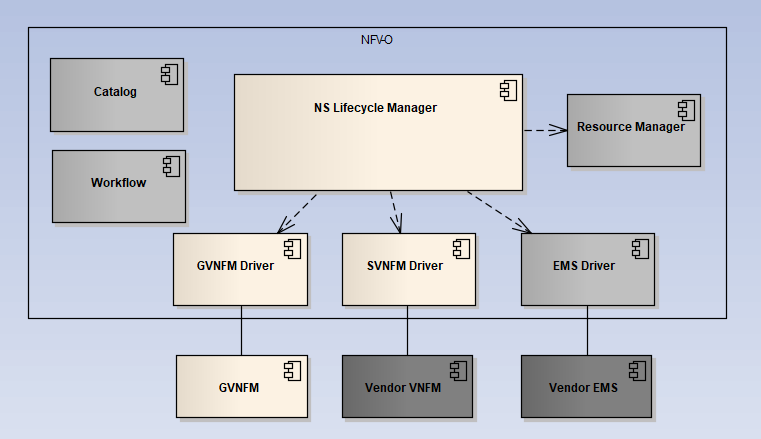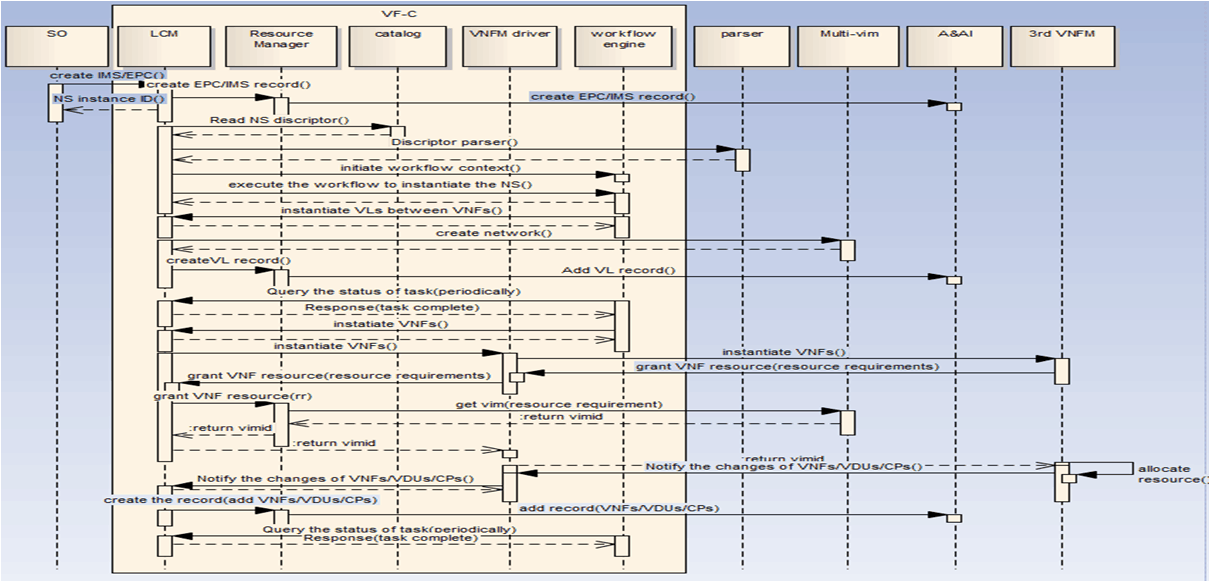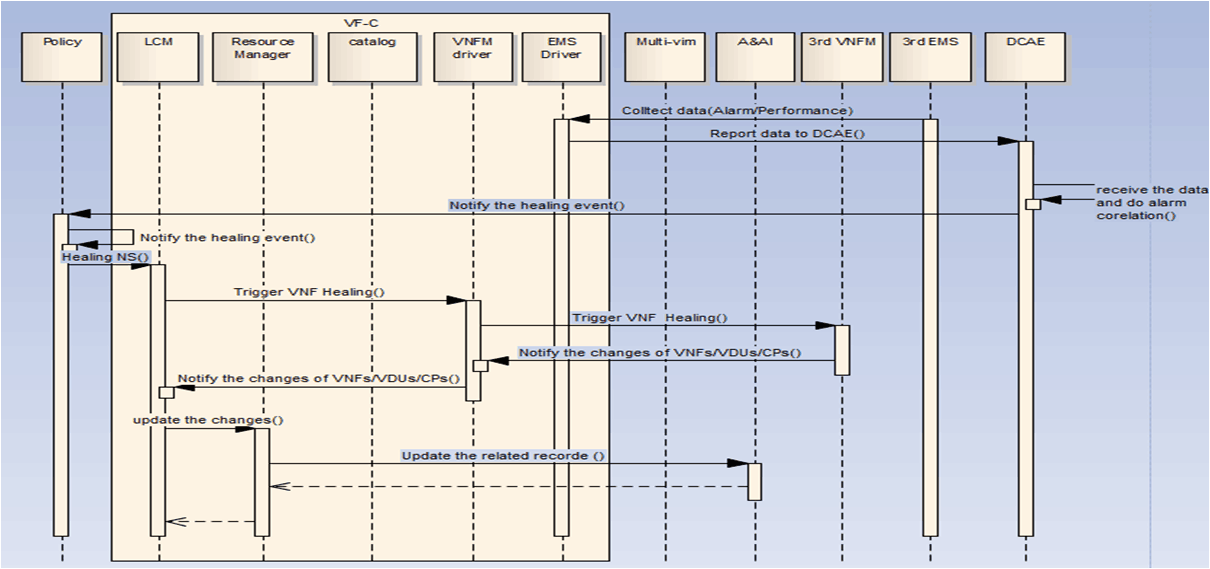VF-C Architecture
VF-C Internal Component
This shows all VF-C components, each component is a standalone microservice, these microservice including:
nslcm is the core component, mainly responsible for network service management.
catalog is used to package management, including NS/VNF/PNF package management.
Resource Manager is used to manage the instance created by VF-C and also responsible for resource granting.
SVNFM Driver, now VF-C has three specific vendor VNFM drivers, including nokia/huawei/zte driver, each driver is a microservice.
GVNFM Driver, now has two generic VNFM driver, including gvnfm driver and juju driver.
SFC Driver, it migrates from Open-O seed code and now hasn’t been used in any use case in ONAP.
Wfengine-mgrservice provides the workflow management service. Now it has been integrated with activiti workflow and provides the unified interface to external components.
Wfengine-activiti, it is as the activiti work flow microservice.
Multivim-proxy provides the multivim indirect mode proxy which can forward virtual resource requests to multivim and does some resource checking.
EMS Driver is used for VNF performance and alarm data collection and reports to DCAE VES collector.
GVNFM includes three micorservices: vnflcm, vnfmgr and vnfres and the core is vnflcm which is responsible for VNF life cycle management.
DB, provides database services for each VF-C component.
- Note:
SFC Driver migrated from Open-O seed code and now hasn’t been used in any usecase in ONAP. This component is deprecated from Guilin Release.
Resource Management is used to do the resource granting, but now VF-C has been integrated with OOF, this component is deprecated from Guilin Release.
DB provides the stand-alone database microservice in casablanca release, but now VF-C leverages OOM shared MariaDB-Gelera cluster. This repo still has redis to be used by VF-C component.
Catalog has been migrated to Modeling project since Frankfurt Release.
Wfengine-mgrservice & Wfengine-activiti are deprecated from Guilin Release since VF-C uses build-in workflow process.
Multivim-proxy & EMS Driver & nokia driver & juju driver are deprecated from Guilin Release since they are no longer used or maintained.
VF-C External Dependency
As you can see in this picture, VF-C has many dependencies with other projects, such as SO, Policy, A&AI, DCAE, Multi-cloud and so on.
NFVO provides north bound interface to SO to take part in fulfilling the orchestration and operation of end2end service and provides standard south bound interface to VNFMs.
GVNFM provides LCM for VNFs which do not require a vendor VNFM and works with NFV-O component to take part in fulfilling the LCM of NS.
VF-C provides VNFM driver interfaces, vendor can implement these to integrate with VF-C. Now, VF-C has integrated with three vendor VNFM, including ZTE, Huawe, Nokia.
In addition, VF-C also provides interface to Policy and works with DCAE for Close Loop Automation.
In Casablanca release, VF-C is also integrated with OOF to do the resource homing and placement.
VF-C Usecase and Workflow
VF-C support VoLTE use case, vCPE use case in the first three releases and support CCVPN use case in Dublin release.
VoLTE usecase information can be found : https://wiki.onap.org/pages/viewpage.action?pageId=6593603
vCPE usecase information can be found : https://wiki.onap.org/pages/viewpage.action?pageId=3246168
CCVPN usecase information can be found : https://wiki.onap.org/pages/viewpage.action?pageId=45296665
Taking VoLTE as an example to describe the VF-C internal workflow:
VF-C Instantiate
The workflow:
SO send request to LCM to deploy vIMS+vEPC network service.
LCM talk with Resource Manager and then A&AI to create NS instances in A&AI inventory.
LCM get NSD from VF-C catalog.
LCM parse the NS model via TOSCA parser to decompose NS to VNFs and recognize the relationship between VNFs.
LCM init workflow context and execute NS instantiation.
Workflow will invoke LCM to instantiate VLs between VNFs.
LCM talk with Multi-VIM to create virtual network connections between VNFs if needed.
LCM talk with Resource manager to create related virtual link instances to A&AI inventory(Not included in R1).
When VL is created ,workflow will invoke LCM to instantiate VNFs.
LCM send request to S-VNFM Driver and work with S-VNFM to deploy each VNFs.
Aligned with ETSI specs work flow, VNFM need to send granting resource request to LCM,LCM transfer this request to Resource manager and then response the granting result and related VIM information(such as url/username/password etc) to VNFM.
VNFM call VIM API to deploy VNF into VIM.
VNFM send notification to LCM to notify the changes of virtual resources, including VDU/VL/CP/VNFC etc.
LCM talk to Resource manager to create/update related records in A&AI inventory
2.VF-C Terminate
The workflow:
SO talk with VF-C to request deletion of vIMS/vEPC network services
Lcm work with Resource Manager to check all vIMS/vEPC instances in A&AI
LCM invoke workflow to delete NS instance
First, workflow will execute deleting VNFs by invoking LCM
LCM talk with S-VNFM Driver to request deletion of VNFs and related resources
Aligned with ETSI specs work flow, VNFM will delete/release virtual resources with the granting to LCM
LCM transfer the grant request to Resource Manager and then response the granting result and related VIM information(such as url/username/password etc) to VNFM.
VNFM delete VNFs and related resources and notify the changes(releasing) of virtual resources to LCM
Lcm talk with Resource Manager to update/delete related resource instances in A&AI inventory
When above work finish, workflow will delete VLs
LCM talk with Multi-VIM to request deletion of virtual network connected to VNFs
Multi-VIM delete related virtual network resources, such as network, sub-network and port etc.
LCM talk with Resource Manager to update/delete related VL resource instances in A&AI inventory(Not included in R1)
LCM talk with Resource Manager to update/delete related NS instances in A&AI inventory
VF-C Healing
The workflow:
EMS Driver collects VNF service level FCAPS in real-time or period.
EMS Driver will transfer VNF service level FCAPS metrics to DCAE with VES data format.
Data filtering/cleaning inside DCAE, DCAE can send related events to data bus. Holmes can keep track of the events published to data bus and do the alarm correlation analysis based on the imported rules then Holmes send the result and root cause to the event bus.
Policy engine subscribe related topic on event bus. After receiving auto-healing triggering events, matching the events with exist rules.
Policy invoke VF-C APIs to do the action of auto-healing once matching events with healing rules.
LCM talk with VNFM driver to restart VNF and receive the changes of virtual resources.
LCM talk with Resource Manager to update/create related instance information to A&AI inventory according to the changes of resources.
If you would like to know more details about vCPE, you can refer https://wiki.onap.org/display/DW/vCPE+with+Tosca+VNF+Test+Guide




